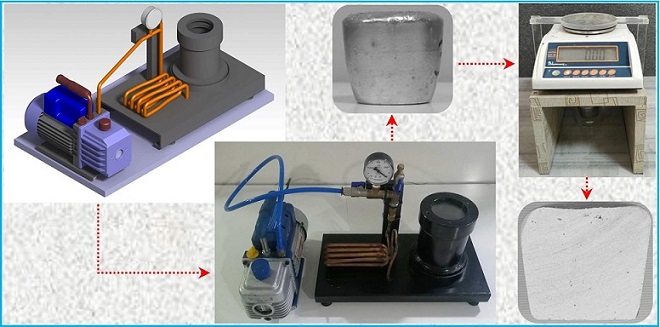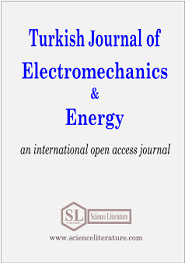
Design and manufacturing of reduced pressure test machine for determination of liquid aluminum quality in casting
Abstract
Secondary aluminum derived from discarded aluminum and its alloy products is referred to as scrap. The use of secondary aluminum is significant due to reducing the raw material costs, conserving the energy and being beneficial to the environment. It's critical to ensure the quality of the liquid metal when utilizing secondary aluminum. To produce higher quality parts, the liquid aluminum must be free from undesirable substances. The liquid aluminum is cleaned by myriad techniques depending on the capacity and conditions of the foundry, and its cleanliness is controlled by different test methods. This study involved the design and manufacturing of the most commonly used vacuum solidification device to assess the liquid metal quality after cleaning scrap aluminum alloys. The device's effectiveness was evaluated through post-production assembly and experimental studies, which yielded positive results in determining the liquid metal quality.
Full Text:
PDFReferences
C. R. Brooks, "Heat Treatment, Structure and Properties of Nonferrous Alloys," American Society for Metals, Ohio, USA, 1984.
M. Tokatlı, F. Saydam, M. Hal, A. Koşatepe, M. Çolak, Ç. Yüksel, "Investigation of liquid metal cleaning methods commonly used in the casting of aluminium alloys," Journal of the Institute of Science and Technology, 12(1), pp.423-434, 2022.
Ç. Çakanyildirim and M. Gürü, "Developments in aluminium production technologies," environmental impact and application areas," Journal of Polytechnic, 24(2), pp. 585-592, 2021.
M. Çolak, R. Kayikci, D. Dispinar, "Melt cleanliness comparison of chlorine fluxing and Ar degassing of secondary Al-4Cu," Metallurgical and Materials Transactions B, vol. 47, pp. 2705-2709, 2016.
D. Dışpınar and J. Campbell, "Determination of aluminum casting quality," 4th National Aluminum Symposium, İstanbul, Türkiye, pp. 394-404, 2009.
D. Dispinar and J. Campbell, "Porosity, hydrogen and bifilm content in Al alloy castings," Materials Science and Engineering: A, 528(10-11), pp. 3860-3865, 2011.
G. J. Kaufman and E. L. Rooy, "Aluminum alloy castings: properties, processes, and applications," ASM International, vol. 05114G, pp. 39-53, 2004.
F. Chiesa and P. Regimbal, "Distinguishing microporosity from macroshrinkage when modeling solidification of A 356 castings," In Transactions of the American Foundry Society and the One Hundred Fifth Annual Castings Congress, pp.1-11, 2001.
E. Erzi, Ö. Gürsoy, Ç. Yüksel, M. Çolak, D. Dispinar, "Determination of acceptable quality limit for the casting of A356 aluminium alloy: supplier’s quality index (SQI)," Metals, 9(9), pp. 957, 2019.
M. Tokatlı, E. Uslu, M. Çolak, Ç. Yüksel, "Investigation of the effect of liquid metal quality on feedability in the casting of A356 aluminium alloys," Turkish Journal of Electromechanics and Energy, 7(3), pp. 105-109, 2022.
E. Tan, A. R. Tarakcılar, D. Dıspınar, M. Colak, R. Kayıkcı, "Reproducibility of reduced pressure test results in testing of liquid aluminum gas levels," In 6th International Advanced Technologies Symposium (IATS’11), pp.321-324, Elazığ, Turkiye, 16-18 May 2011.
A. Tigli, M. Tokatli, E. Uslu, M. Colak, D. Dispinar, "Correlation between K-value, density index and bifilm index in determination of liquid Al cleanliness," Archives of Foundry Engineering, 23(3), pp.22-29, 2023.
H. E. İslamoğlu, "Thermal analysis of eutectic modified and grain refined aluminum-silicon alloys," Master’s Thesis, Middle East Technical University, Ankara, 2005.
O. Lashkari, L. Yao, S. Cockcroft, D. Maijer, "X-ray microtomographic characterization of porosity in aluminum alloy A356," Metallurgical and Materials Transactions A, vol. 40, pp.991-999, 2009.
M. Brůna and A. Sládek, "Hydrogen analysis and effect of filtration on the final quality of castings from aluminum alloy AlSi7Mg0. 3," Archives of Foundry Engineering, 11(1), pp. 5-10, 2011.
N. Habibi, A. M. Samuel, F. H. Samuel, P. Rochette, D. Paquin, "Effect of grain refining and Sr modification on Prefil measurement sensitivity in 356 alloys using electron probe microanalysis technique," International Journal of Cast Metals Research, 17(2), pp. 79-87, 2004.
A. M. Samuel, H. W. Doty, S. Valtierra, F. H. Samuel, "Inclusion measurements in Al–Si foundry alloys using qualiflash and prefil filtration techniques," International Journal of Metalcasting, vol. 12, pp. 625-642, 2018.
S. W. Hudson and D. Apelian, "Inclusion detection in molten aluminum: current art and new avenues for in situ analysis," International Journal of Metalcasting, vol. 10, pp. 289-305, 2016.
M. B. Djurdjević, Z. Odanović, J. Pavlović-Krstić, "Melt quality control at aluminum casting plants," Metallurgical & Materials Engineering, 16(1), pp. 63-76, 2010.
E. Uslu and S. H. Yetgin, "Investigation of the effect of mechanical vibration, cooling plate and grain refinement in the sand moulding of A360 aluminium casting alloy," TURAN-CSR: TURAN Center for Strategic Researches, 13(52), pp. 228-234, 2021.
D. Dispinar and J. Campbell, "Critical assessment of reduced pressure test. Part 2: Quantification, International Journal of Cast Metals Research, 17(5), pp. 287-294, 2004.
K. J. Brondyke, and P. D. Hess, "Interpretation of vacuum gas test results for aluminium alloys," Trans. TMS-AIME, vol. 230, pp. 1542-46, 1964.
URN: https://sloi.org/urn:sl:tjoee83292
Copyright (c) 2023 Turkish Journal of Electromechanics and Energy

This work is licensed under a Creative Commons Attribution-NonCommercial 4.0 International License.

 Indexed in:
Indexed in:
















